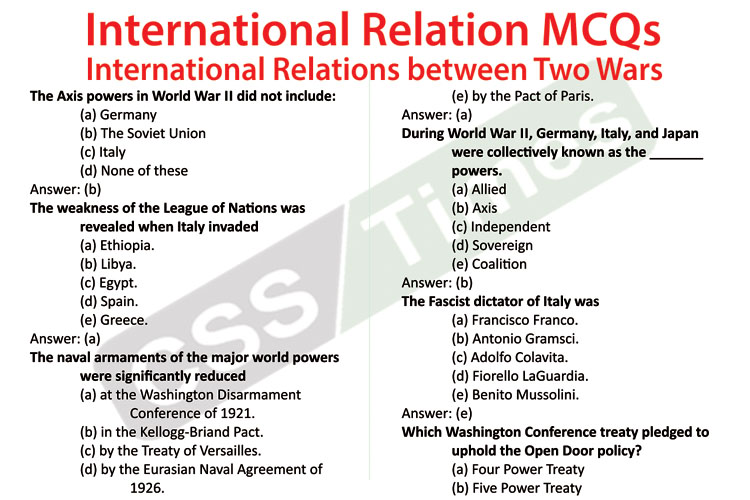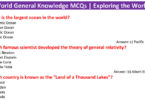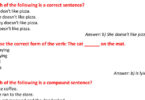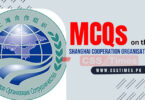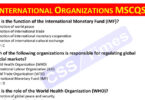International Relation MCQs
International Relations between Two Wars
The Axis powers in World War II did not include:
(a) Germany
(b) The Soviet Union
(c) Italy
(d) None of these
Answer: (b)
The weakness of the League of Nations was revealed when Italy invaded
(a) Ethiopia.
(b) Libya.
(c) Egypt.
(d) Spain.
(e) Greece.
Answer: (a)
The naval armaments of the major world powers were significantly reduced
(a) at the Washington Disarmament Conference of 1921.
(b) in the Kellogg-Briand Pact.
(c) by the Treaty of Versailles.
(d) by the Eurasian Naval Agreement of 1926.
(e) by the Pact of Paris.
Answer: (a)
During World War II, Germany, Italy, and Japan were collectively known as the _______ powers.
(a) Allied
(b) Axis
(c) Independent
(d) Sovereign
(e) Coalition
Answer: (b)
The Fascist dictator of Italy was
(a) Francisco Franco.
(b) Antonio Gramsci.
(c) Adolfo Colavita.
(d) Fiorello LaGuardia.
(e) Benito Mussolini.
Answer: (e)
Which Washington Conference treaty pledged to uphold the Open Door policy?
(a) Four Power Treaty
(b) Five Power Treaty
(c) Nine Power Treaty
(d) Kellogg-Briand Pact
(e) Camp David Treaty
Answer: (c)
The United States’ response to Japan’s invasion of Manchuria was
(a) to refuse to recognize Japan’s seizure of the territory.
(b) to blockade Japanese ports until Japan removed its forces.
(c) to sever diplomatic relations with Japan.
(d) to embargo all trade with Japan.
(e) declare war on Japan.
Answer: (a)
In 1931, the illusion of peace was shattered by the Japanese invasion of
(a) Korea.
(b) Malaysia.
(c) Philippines.
(d) Manchuria.
(e) Siberia.
Answer: (d)
The anti-Comintern pact completed in 1937 included
(a) Germany, Japan, and Russia.
(b) Russia, France, and England.
(c) Germany, Italy, and Russia.
(d) Germany, Italy, and Japan.
(e) Russia, Poland and the Baltic States.
Answer: (d)
In the 1930s, support for pacifism was particularly strong among
(a) college students.
(b) the lower classes.
(c) high-ranking businessmen.
(d) members of Congress.
(e) labor unions.
Answer: (a)
The Senate Nye Committee hearings of the 1930s
(a) proposed complete United States disarmament.
(b) relied, in part, on the “merchants of death” thesis to explain n United States participation in World War I.
(c) condemned the Italian invasion of Ethiopia.
(d) called for an Anglo-American military alliance.
(e) oversaw early atomic research.
Answer: (b)
During World War II, the United States’ closest ally was
(a) Soviet Union (b) Canada.
(c) France (d) England.
(e) China.
Answer: (d)
Great Britain’s leader during World War II was
(a) Henry L. Stimson.
(b) Neville Chamberlain.
(c) Charles De Gaulle.
(d) Winston Churchill.
(e) George C. Marshall.
Answer: (d)
During the war, U.S.-Soviet relations were
(a) close and tranquil.
(b) constantly strained by significant ideological differences.
(c) totally uncooperative.
(d) hurt by the United States’ refusal to extend recognition to the Soviet Union as a cobelligerent.
(e) influenced by F.D.R.’s personal dislike for Stalin.
Answer: (b)
In December 1941, the U.S. declared war on Germany because
(a) the American people demanded it.
(b) of the attack on Pearl Harbor.
(c) Germany had invaded Britain.
(d) Germany had declared war on the U.S.
(e) it seemed like the thing to do.
Answer: (d)
Britain and France responded to initial German aggression by
(a) attempting to appease Hitler.
(b) immediately threatening war.
(c) establishing a military alliance with the Soviet Union.
(d) seizing German territory.
(e) blockading German ports.
Answer: (a)
The Munich Conference considered Germany’s demands on
(a) the Rhineland.
(b) Austria.
(c) the Polish Corridor.
(d) the Sudeten region of Czechoslovakia.
(e) the Alsace.
Answer: (d)
The American fleet at Pearl Harbor was caught by surprise when Japan attacked because
(a) American intelligence had not been able to break the Japanese code.
(b) of faulty radar equipment.
(c) of human miscalculations and mistakes.
(d) F.D.R. conspired to get the United States into the war by provoking a Japanese attack.
(e) American intelligence had incorrectly decoded an intercepted message.
Answer: (c)
The Lend-Lease Act of 1941
(a) ensured the British easier access to American war supplies.
(b) placed restrictions on which materials the United States could ship to Great Britain.
(c) encountered almost no opposition from American congressmen.
(d) was proposed by American isolationists.
(e) was approved but never implemented.
Answer: (a)
With the outbreak of war in Europe in 1939, President Roosevelt
(a) immediately declared war on Germany.
(b) declared American neutrality.
(c) loaned massive quantities of war supplies to France and England.
(d) warned Germany that if France were attacked, the United States would declare war.
(e) made a secret pact with the French.
Answer: (b)

